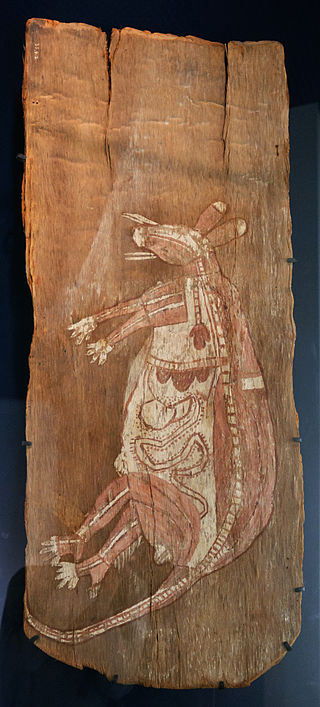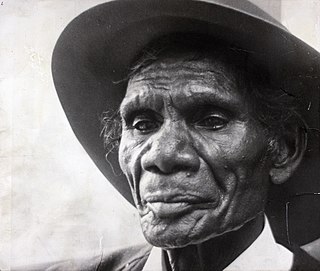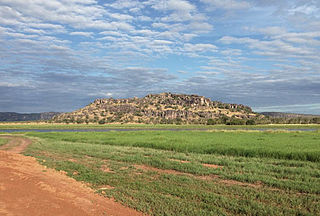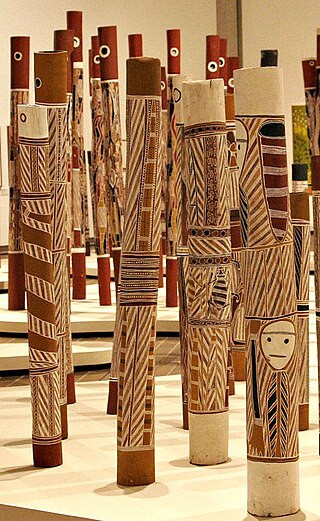Related Research Articles

Indigenous Australian art includes art made by Aboriginal Australians and Torres Strait Islanders, including collaborations with others. It includes works in a wide range of media including painting on leaves, bark painting, wood carving, rock carving, watercolour painting, sculpting, ceremonial clothing and sandpainting. The traditional visual symbols vary widely among the differing peoples' traditions, despite the common mistaken perception that dot painting is representative of all Aboriginal art.

Bark painting is an Australian Aboriginal art form, involving painting on the interior of a strip of tree bark. While examples of painted bark shelters were found in the south-eastern states of Tasmania, Victoria, and New South Wales in the 19th century, as well as later on bark shelters in northern Australia, it is now typically only found as a continuing form of artistic expression in Arnhem Land and other regions in the Top End of Australia, including parts of the Kimberley region of Western Australia.

John Mawurndjul is a highly regarded Australian contemporary Indigenous artist. He uses traditional motifs in innovative ways to express spiritual and cultural values, He is especially known for his distinctive and innovative creations based on the traditional cross-hatching style of bark painting technique known as rarrk.

Gunbalanya is an Aboriginal Australian town in west Arnhem Land in the Northern Territory of Australia, about 300 kilometres (190 mi) east of Darwin. The main language spoken in the community is Kunwinjku. At the 2021 Australian census, Gunbalanya had a population of 1,177.

Yirawala was an Aboriginal Australian leader, labourer and bark painter, most known for his artistic works. He was born in the Northern Territory, which at the time was responsibility of the state of South Australia, and died in Minjilang, otherwise known as Croker Island. He was extremely influential in promoting the acceptance of Aboriginal works as fine art, instead of "ethnographic material."[14] He was intensely concerned with the preservation of his culture, and he played an important role as an educator and mentor for young Aboriginal artists. His works can now be found in galleries across the world, and his influence lives on through the artists he inspired and the innovations he introduced to the artistic community. When Harold Thomas, the creator of the Aboriginal Flag was asked “Who do you think were our greatest artists?”, he responded: "I would have no hesitation to say Yirawala and Mandarkk. If I were to compare the two with any others I would say Yirawala is our Picasso, Mandarkk our Braque."

Injalak Arts, formerly known as Injalak Arts and Crafts, is a non-profit, community-owned Aboriginal art centre located in Gunbalanya, around 300 km (190 mi) east of Darwin in West Arnhem Land in the Northern Territory of Australia. It was incorporated in 1989. It is known for artists working in a primarily figurative style, and continuing and developing the West Arnhem rock art tradition. It is also known for pandanus weavings. Artists are mostly Kunwinjku people; however, artists from many language groups across Arnhem Land are represented.

Bardayal "Lofty" Nadjamerrek was a Kunwinjku Aboriginal artist of the Mok clan. He belonged to the Duwa moiety and spoke the Kundedjnjenghmi language. He is currently referred to by his skin and clan as "Wamud Namok", following the Kunwinjku custom of avoiding use of the name of deceased persons.
Bobby Barrdjaray Nganjmirra was a Kunwinjku Aboriginal artist of the Djalama clan and Yirridjdja moiety.

Gabriel Maralngurra is an artist from the Ngalangbali clan Kunwinjku artist in West Arnhem Land. As an Aboriginal artist, he is well-known and respected within his community for the wide range of responsibilities he takes on. His artwork is displayed in various collections including the Australian Museum, Museum Victoria, and the Kluge-Ruhe Aboriginal Art Collection of the University of Virginia.
Wanurr Bob Namundja (c.1933–2005) was an Aboriginal Australian artist known for his bark paintings.

Joe Guymala is an Aboriginal Australian artist and musician of the Burdoh clan of the Kunwinjku people, known for his paintings on bark, paper and memorial poles known as lorrkkon.
Djambawa Marawili is an Aboriginal Australian artist known for bark painting, wood sculpture, and printmaking. He is also a musician, and released an album in 2008.

Ruth Nalmakarra is an Indigenous Australian artist known for her weaving, painting, and community leadership.
Mawalan Marika (c.1908–1967), often referred to as Mawalan 1 Marika to distinguish from Mawalan 2 Marika, was an Aboriginal Australian artist and the leader of the Rirratjingu clan of the Yolngu people of north-east Arnhem Land, in the Northern Territory of Australia. He is known for his bark paintings, carvings and political activism.
Lucy Malirrimurruwuy Armstrong Wanapuyngu is an Aboriginal Australian master fibre artist. She is an elder of the Gapuwiyak community, and is heavily involved in the transmission of knowledge dealing with fibre works. She has worked with anthropologist Louise Hamby, since 1995, and many of her works have been spotlighted at different art festivals, collections, galleries, and museums.
Peter Marralwanga (1916–1987), also known as Djakku, was an Aboriginal Australian artist known for his paintings. He was a member of the Kardbam clan of the Bininj people, and spoke the Kuninjku language. In addition to being a ceremonial leader, Marralwanga also helped found the Marrkolidjban outstation near Maningrida in 1972, with the help of artists Yirawala, Mick Mandayngu and Curly Barrkadubu. For most of his life, Marralwanga lived at the remote outstation, but briefly lived at the government settlement at Maningrida.
Mick Kubarkku (c.1922-2008) was regarded as a prominent Aboriginal Australian artist most associated with Kuninjku modernism.

A memorial pole, also known as hollow log coffin, burial pole, lorrkkon, ḻarrakitj, or ḏupun, is a hollow tree trunk decorated with elaborate designs, made by the Yolngu and Bininj peoples of Arnhem Land in the Northern Territory of Australia. Originally used to hold the bones of deceased people or for burial ceremonies, they are now made as works of art. The permanent exhibit at the National Gallery of Australia, Aboriginal Memorial, consists of 200 hollow log coffins, created by 43 artists.

Graham Badari is an Aboriginal Australian artist from the Wardjak clan in West Arnhem Land. Graham Badari belongs to the Duwa moeity and speaks the Kunwinjku dialect. At Injalak Arts, Badari is a popular figure, a tour guide, and a font of community news. Art historian Henry Skerritt describes him as possessing a "impish smile and cheeky sense of humour" and a "unique and eccentric personality"
Paddy Compass Namadbara, skin name Na-Bulanj, was an Aboriginal Australian artist and traditional healer, or marrkidjbu, from western Arnhem land. He was a member of the Alarrdju clan. Namadbara was renowned for his abilities as a healer, his bark paintings, and his skills as a mentor for younger generations.
References
- 1 2 3 4 5 6 7 8 9 Anthony Murphy, "Thompson Yuludjirri," Unpublished obituary, 2009.
- 1 2 3 4 5 6 Megan de Groot, Alyson (February 2009). "The Significance of Fibre Art: People, Place, and Environment" (PDF). Charles Darwin University.
- 1 2 3 4 Sanz, Inés Domingo; Fiore, Dánae; May, Sally K. (October 2009). ARCHAEOLOGIES OF ART: TIME, PLACE, AND IDENTITY. Left Coast Press. ISBN 978-1-59874-265-7.
- ↑ May, Sally K. (2008). Archaeologies of Art: Time, Place, and Identity. Routledge. pp. 171–194. Retrieved 5 May 2024.
- ↑ May, Sally K. (2008). Archaeologies of Art: Time, Place, and Identity. Routledge. p. 174. Retrieved 5 May 2024.
- ↑ May, Sally K. (2008). Archaeologies of Art: Time, Place, and Identity. Routledge. p. 182. Retrieved 5 May 2024.
- 1 2 McLean, Ian, 1952- (2014). Double desire : transculturation and indigenous contemporary art. ISBN 978-1-4438-6743-6. OCLC 953517581.
{{cite book}}: CS1 maint: multiple names: authors list (link) CS1 maint: numeric names: authors list (link) - 1 2 3 4 5 6 7 8 9 10 11 12 13 Van Nest, Lauren (2019). 'The Stories Will Never Be Forgotten': Reframing Contemporaneity and Authenticity in Western Arnhem Land Paintings. Charlottesville: Kluge-Ruhe Aboriginal Art Collection of the University of Virginia. ISBN 9780999830369.
- ↑ "GARRY DJORLOM Gunbalanya". Creative Cowboy Films. Retrieved 2 May 2020.
- ↑ "Showcasing Dreams of the Aborigine in West Hollywood". Los Angeles Times. 18 September 1988. Retrieved 2 May 2020.
- ↑ "Kluge-Ruhe Collection Unveils Unique Aboriginal Art for Student Research". UVA Today. 6 April 2015. Retrieved 2 May 2020.
- ↑ Erickson, Dorothy (1997). "Andrew Carter: Theatre Designer to the World". Artlink Australia: 59–61. Retrieved 6 May 2024.
- ↑ "Mimi: About the Production". Marrugeku. Retrieved 5 May 2024.
- ↑ "Making Crying Baby: RealTime interview with Rachael Swain". RealTime (RealTime Issue #41): 8–9. February 2001. Retrieved 5 May 2024.
- ↑ O'Rourke, Claire (18 January 2001). "Crying Baby Stories Explore Our Nation In Its Infancy". John Fairfax Publications Pty Limited. Sydney Morning Herald. Retrieved 5 May 2024.
- 1 2 3 4 5 6 Chaloupka, George (2005). Strands of time. OCLC 1011273156.
- 1 2 Hamby, Louise (2005). Twined Together - Kunmadj Njalehnjaleken. Injalak Arts and Crafts. ISBN 9780646446080 . Retrieved 5 May 2024.
- ↑ Taylor, Luke (June 1990). "The Rainbow Serpent as Visual Metaphor in Western Arnhem Land". Oceania. 60 (Special 60th Anniversary Issue): 329–344. JSTOR 40332450 . Retrieved 5 May 2024.
- ↑ "Beyond Dreamings: The Rise of Indigenous Australian Art in the USA". Kluge-Ruhe. Retrieved 2 May 2020.
- ↑ Yulidjirri, Thompson Australian Print Workshop. "Namarrkon". Item held by National Gallery of Australia. Retrieved 2 May 2020.
- ↑ "Thompson Yulidirri | Artists | NGV". www.ngv.vic.gov.au. Retrieved 2 May 2020.
- ↑ "Yulidjirri, Mr. Thomspon". National Museum of Australia. Retrieved 2 May 2020.